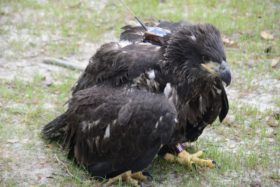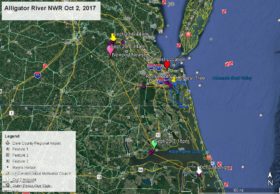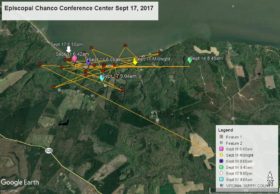How Do I Get Out Of This Egg?
Do Azalea’s Parents Recognize Her?
March 5, 2010Hope the whimbrel returns
March 5, 2010
Photo from Webcam March 24, 2009 at 5:02pm – This is the third egg to hatch (other two chicks are under moms wing) and chick will be banded HE. You can see the adult female looking at the hole that has been “pipped” in the eggshell. The eaglet finally broke out of the shell the next morning at 7:12am.
The most anticipated event of the 2010 season is just about here: The hatching of the bald eagle eggs in the nest at Norfolk Botanical Garden.
So how does the chick (also called an eaglet or hatchling) get out of that white oval shaped eggshell? By now the developing embryo is almost fully formed and has developed a strong muscle on the back of its neck called a “hatching muscle”, and a small sharp “egg tooth” on its upper beak. Hatching is a very physical process and a challenge that can take 2 to 4 days. Up to this time the soon to be hatchling has been all folded up, but now begins to stretch out, and punctures the inner membrane with its beak at the blunt end of the egg and for the first time breathes “air”. The chick then slowly rotates counterclockwise by pivoting its legs and with the “egg tooth” scratches the inside of the shell. With the “hatching muscle” it punches a hole (called pipping) in the eggshell. With body movements and stretching the eaglet breaks the eggshell into two pieces and the hatching process is finally complete.
Additional recommended reading – “What’s happening inside those eggs?” by Stephen Living on DGIF blog archive March 18, 2009




2 Comments
That is so interesting Reese. Thanks for posting this so we could all understand this process we are about to witness. Well, I hope I get to see it!
Thanks Reese for bringing us from beginning to end. Had never known about this birth process.